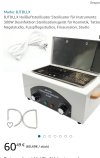I'm not the person you're asking, but I can explain how it is done in a laboratory setting.
First, you prepare a soapy water bath and place all your vials in there. You can use a bottle brush or even a twisted up paper towel to make sure there's no particulate material or a chemical coating from the manufacturing process. After this, you rinse with normal running water, both to remove any soap residue and anything else. Using distilled water at this point is overkill.
Next, for the distilled water rinses, you want to fill the interior of the vial with the distilled water. The first time or two, it is not a bad idea to put a GLOVED thumb over the vial mouth and shake. This agitation helps get any leftover stuff from adhering to the side of the vial, even though the contact with your thumb isn't perfectly clean. The next couple of rinses, you don't want to touch the mouth of the vial at all, so that any thing that was on that small bit of your glove surface is washed out. You just fill the vial, dump the vial.
After the final distilled water rise, place the vial upside down on top of a piece of baked aluminum foil. This will prevent anything dust from falling into the mouth. (Just get some cheap, store brand foil with no coating, remove it from the roll, and bake it at 500 for an hour.)
This type of cleaning protocol is not only good for microbiology, but also for glassware to be used in chemical analysis of organics. So we're not talking about whole cells fucking up the analysis, we're talking about the oils from human skin wrecking everything.


